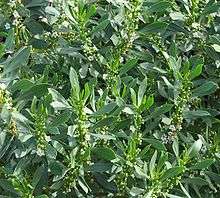Myoporum insulare
Myoporum insulare, commonly known as common boobialla, native juniper or blueberry tree[1] is a flowering plant in the figwort family Scrophulariaceae and is endemic to coastal areas of Australia. It is a shrub or small tree which grows on dunes and coastal cliffs, is very salt tolerant and widely used in horticulture.
.jpg)
| Common boobialla | |
|---|---|
 | |
| Myoporum insulare at Black Rock, Victoria | |
| Scientific classification | |
| Kingdom: | Plantae |
| Clade: | Tracheophytes |
| Clade: | Angiosperms |
| Clade: | Eudicots |
| Clade: | Asterids |
| Order: | Lamiales |
| Family: | Scrophulariaceae |
| Genus: | Myoporum |
| Species: | M. insulare |
| Binomial name | |
| Myoporum insulare | |
 | |
| Occurrence data from GBIF | |
| Synonyms[2] | |
| |
Description
Boobialla varies in form from a prostrate shrub to a small, erect tree growing to a height of 6 metres (20 ft). It has thick, smooth green leaves which are 30–90 millimetres (1–4 in) long and 7–22 millimetres (0.3–0.9 in) wide with edges that are either untoothed or toothed toward the apex. The leaves are egg-shaped and the upper and lower surfaces are the same dull green colour.[2][3][4]
White flowers with purple spots appear in the leaf axils in clusters of 3 to 8 and are 6–8 millimetres (0.2–0.3 in) in diameter. There are 5 glabrous, smooth sepals and the tube formed by the petals is 2.3–3.6 millimetres (0.09–0.1 in) long with the lobes of the tube about the same length. The four stamens usually extend slightly beyond the tube. Peak flowering times are July to February in Western Australia and October to December in south-eastern Australia. Flowering is followed by the fruit which is a smooth, rounded purple to black drupe 4.5–9 millimetres (0.2–0.4 in) in diameter.[2][3][4][5]
Taxonomy and naming
Myoporum insulare was first formally described by botanist Robert Brown in Prodromus Florae Novae Hollandiae in 1810.[1][6] The specific epithet insulare is a Latin word meaning "from an island".[7]
Distribution and habitat
Myoporum insulare occurs in coastal areas of New South Wales, Victoria, South Australia, Western Australia and Tasmania.[2] In New South Wales it occurs from Eden southward, although an isolated occurrence was recorded much further north on Brush Island.[5] It is also found on Lord Howe Island.[5][8] In Victoria it is found in coastal areas but also inland in the west of that state.[9] Boobialla is common along the coast of South Australia[10] and in Western Australia it occurs south from Shark Bay to the South Australian border.[11] It grows in sandy soils, often between rocks or near sandstone.[5][11]Myoporum insulare is invasive in several African countries and in the western coastal areas of the USA. Invasive populations may include some other species of this genus. In South Africa this species is known as manatoka.[12]
Uses
References
- "Myoporum insulare". Australian Plant Name Index (APNI), IBIS database. Centre for Plant Biodiversity Research, Australian Government.
- Chinnock, Robert J. (2007). Eremophila and allied genera : a monograph of the plant family Myoporaceae (1st ed.). Dural, NSW: Rosenberg. pp. 108–110. ISBN 9781877058165.
- Costermans, L. (1981). Native Trees and Shrubs of South-eastern Australia. Australia: Rigby. ISBN 072701403X.
- Marron, Michele. "Myoporum insulare". Australian National Botanic Garden. Retrieved 23 November 2015.
- Chinnock, Robert. "Myoporum insulare". Royal Botanic Gardens Sydney, Plantnet. Retrieved 23 November 2015.
- Brown, Robert (1810). Prodromus Florae Novae Hollandiae. London: Typis R Taylor, veneunt apud J. Johnson. p. 516. Retrieved 23 November 2015.
- Brown, Roland Wilbur (1956). The Composition of Scientific Words. Washington, D.C.: Smithsonian Institution Press. p. 444.
- "Appendices Lord Howe Island Biodiversity Management Plan" (PDF). Department of Environment and Climate Change (NSW). Retrieved 23 November 2015.
- "Common boobialla". Victorian Resources Online. Retrieved 23 November 2015.
- "Myoporum insulare". Electronic Flora of South Australia Fact Sheet. State Herbarium of South Australia. Retrieved 2008-05-29.
- "Myoporum insulare". FloraBase. Western Australian Government Department of Parks and Wildlife. Retrieved 2008-05-29.
- Glen, Hugh & Van Wyk, Braam (2016) Guide to trees introduced into Southern Africa. pp230-231. Struik Nature, Cape Town
- Cochrane, G.R., Fuhrer, B.A., Rotherdam, E.M., Simmons, J.& M. and Willis, J.H. (1980). Flowers and Plants of Victoria and Tasmania. A.H. & A.W. Reed. ISBN 0-589-50256-5.CS1 maint: multiple names: authors list (link)
- Wrigley, John W.; Fagg, Murray (1983). Australian native plants : a manual for their propagation, cultivation and use in landscaping (2nd ed.). Sydney: Collins. pp. 271–272. ISBN 0002165759.
- Boschen, Norma; Goods, Maree; Wait, Russell (2008). Australia's eremophilas : changing gardens for a changing climate. Melbourne: Bloomings Books. pp. 23–24. ISBN 9781876473655.
- Ellis, M. & Norden, L. 2015. A Field Guide to Coastal Saltmarsh Plants in Victoria, South Gippsland Conservation Society, Inverloch. ISBN 9780959205008
- "Tucker Bush: Boobialla". Retrieved 31 May 2018.